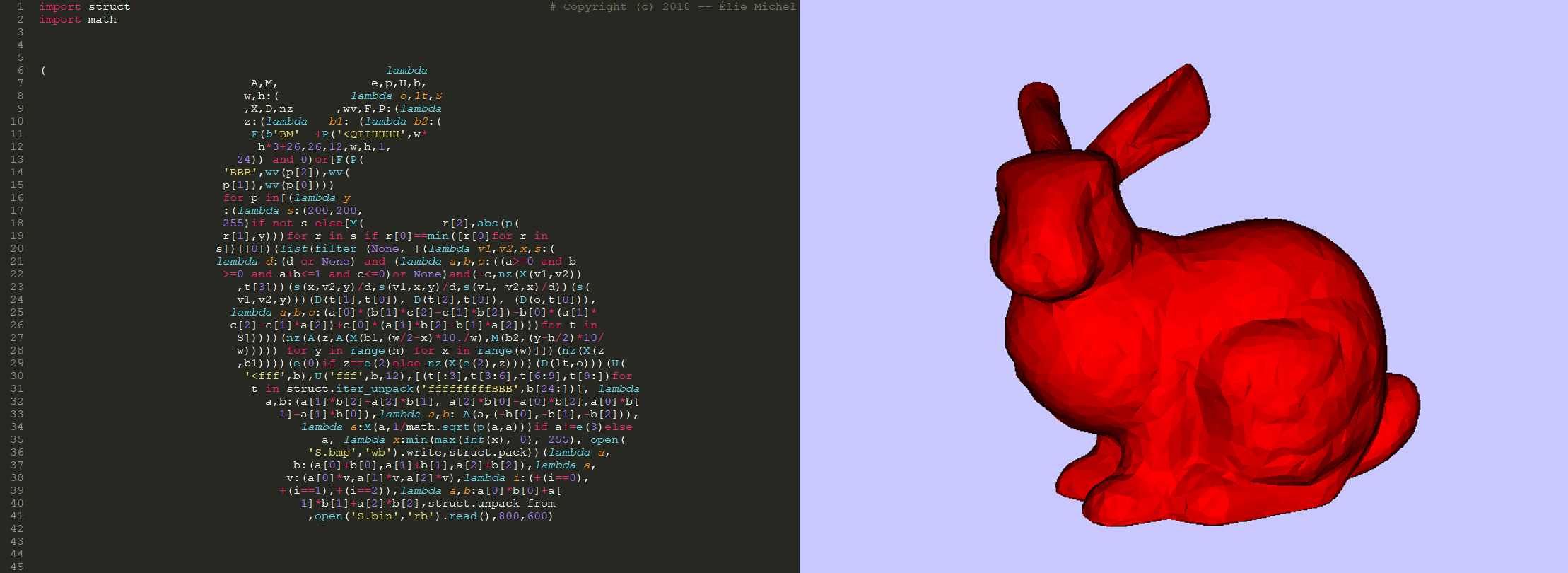A bunny shaped Python code generating a bunny!
A while ago, I bumped into this amazing obfuscated python script generating a Mandelbrot fractal while being itself shaped like its render, and loved it. It is a true calligram in code. And the most impressive to me was that it was done in Python! Since white spaces and line breaks do have a meaning in Python, one is not really free to shape the code at will.
So I took the idea and did my own version. This is a ray tracer, which I got to trace a stanford bunny:

Obfuscated Python Bunny Calligram
#!/usr/bin/python3
# Copyright (c) 2018 -- Élie Michel
import struct
import math
( lambda
A,M, e,p,U,b,
w,h:( lambda o,lt,S
,X,D,nz ,wv,F,P:(lambda
z:(lambda b1: (lambda b2:(
F(b'BM' +P('<QIIHHHH',w*
h*3+26,26,12,w,h,1,
24)) and 0)or[F(P(
'BBB',wv(p[2]),wv(
p[1]),wv(p[0])))
for p in[(lambda y
:(lambda s:(200,200,
255)if not s else[M( r[2],abs(p(
r[1],y)))for r in s if r[0]==min([r[0]for r in
s])][0])(list(filter (None, [(lambda v1,v2,x,s:(
lambda d:(d or None) and (lambda a,b,c:((a>=0 and b
>=0 and a+b<=1 and c<=0)or None)and(-c,nz(X(v1,v2))
,t[3]))(s(x,v2,y)/d,s(v1,x,y)/d,s(v1, v2,x)/d))(s(
v1,v2,y)))(D(t[1],t[0]), D(t[2],t[0]), (D(o,t[0])),
lambda a,b,c:(a[0]*(b[1]*c[2]-c[1]*b[2])-b[0]*(a[1]*
c[2]-c[1]*a[2])+c[0]*(a[1]*b[2]-b[1]*a[2])))for t in
S]))))(nz(A(z,A(M(b1,(w/2-x)*10./w),M(b2,(y-h/2)*10/
w))))) for y in range(h) for x in range(w)]])(nz(X(z
,b1))))(e(0)if z==e(2)else nz(X(e(2),z))))(D(lt,o)))(U(
'<fff',b),U('fff',b,12),[(t[:3],t[3:6],t[6:9],t[9:])for
t in struct.iter_unpack('fffffffffBBB',b[24:])], lambda
a,b:(a[1]*b[2]-a[2]*b[1], a[2]*b[0]-a[0]*b[2],a[0]*b[
1]-a[1]*b[0]),lambda a,b: A(a,(-b[0],-b[1],-b[2])),
lambda a:M(a,1/math.sqrt(p(a,a)))if a!=e(3)else
a, lambda x:min(max(int(x), 0), 255), open(
'S.bmp','wb').write,struct.pack))(lambda a,
b:(a[0]+b[0],a[1]+b[1],a[2]+b[2]),lambda a,
v:(a[0]*v,a[1]*v,a[2]*v),lambda i:(+(i==0),
+(i==1),+(i==2)),lambda a,b:a[0]*b[0]+a[
1]*b[1]+a[2]*b[2],struct.unpack_from
,open('S.bin','rb').read(),800,600)I have to admit that contrary to the Mandelbrot code, this one does not stand alone. It is actually a generic raytracer, which requires a S.bin file as input to describe the scene to render. You can generate this file from Blender, using the following snippet:
import bpy
import struct
f = open("/tmp/S.bin", "wb")
f.write(struct.pack("<ffffff", -10, -10, 2, 0, 0, 0))
def tri(p0, p1, p2, c):
f.write(struct.pack("<fffffffffBBB", p0[0], p0[1], p0[2], p1[0], p1[1], p1[2], p2[0], p2[1], p2[2], c[0], c[1], c[2]))
red = (255, 0, 0)
for obj in bpy.context.selected_objects:
d = obj.data
for p in d.polygons:
v = lambda i: d.vertices[d.loops[p.loop_start + i].vertex_index].co
tri(v(0), v(1), v(2), red)
f.close()You must select the object to export, apply all transforms with Ctrl+A, then run the script. As an example, here is the bunny scene S.bin as well as a simplified version rendering faster S.bin. Also, you may want to start with a much lower resolution, because this code is veeery slow. It took 3h10 to my i5 processor to render the high-poly bunny in 800x600. Here is the exact output: S.bmp.